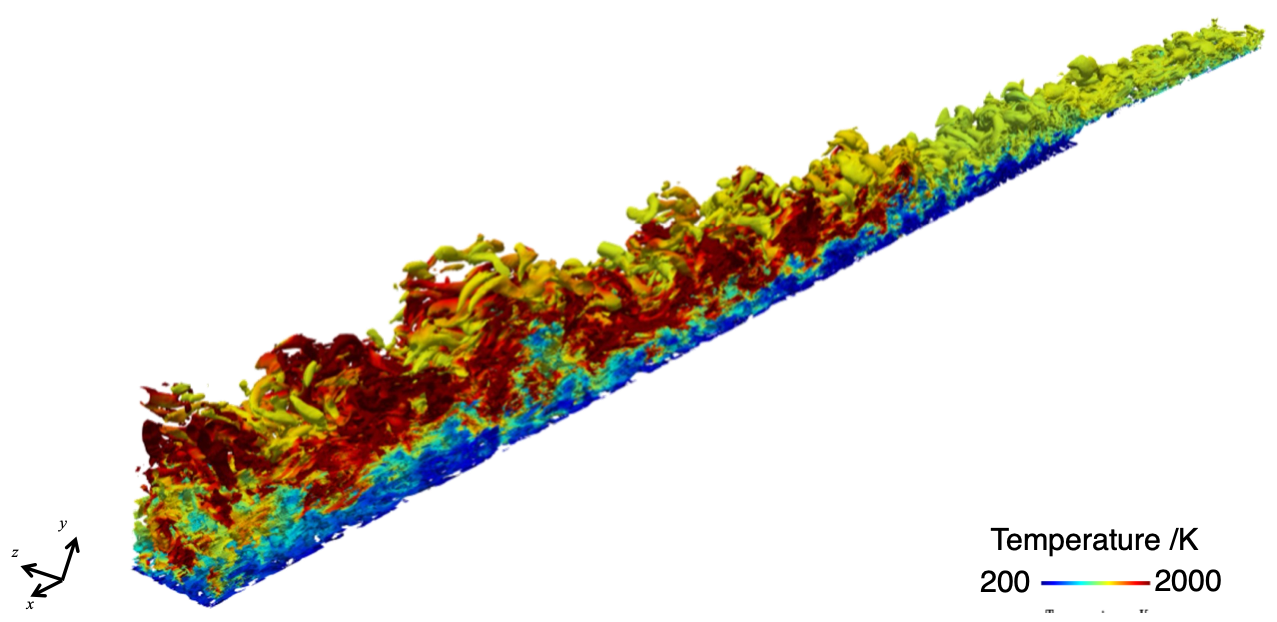Study on Future Space Transportation System using Air-breathing Engines
JAXA Supercomputer System Annual Report February 2022-January 2023
Report Number: R22EG3205
Subject Category: Research and Development
- Responsible Representative: Kouichi Okita, Director, Research and Development Directorate, Research Unit IV
- Contact Information: Masatoshi Kodera(kodera.masatoshi@jaxa.jp)
- Members: Masaaki Fukui, Mizuki Fujiwara, Tatsushi Isono, Taku Inoue, Masatoshi Kodera, Takafumi Tano, Masaharu Takahashi, Sadatake Tomioka, Masahiro Takahashi
Abstract
Recently, reusable rockets have been being studied to reduce the cost of space transportation systems significantly. However, in order to extend the structural lifetime, it is necessary to operate them with relatively low engine power, leading to a decrease in launch capability. Therefore, air-breathing engines such as scramjets and rocket/scram combined cycle engines are promising to compensate the drawback. By using air in the atmosphere as an oxidizer, it becomes highly efficient, and it can be expected to maintain and improve the launch capability even if it is reused. In this project, we will research and develop key technology for practical application of the engine.
Reference URL
N/A
Reasons and benefits of using JAXA Supercomputer System
The following points are raised as problems of engine design by ground experiments. 1) There are limits to reproducing various airflow conditions from takeoff to hypervelocity range. 2) Measured data is limited and complicated three-dimensional flow structure inside the engine can not be well identified. 3) Since the time and cost are limited, it is not easy to change the engine flow path configuration. Therefore, it is indispensable to utilize 3D CFD as a design tool, and a supercomputer is required for performing numerous CFD works efficiently.
Achievements of the Year
(1) A three-dimensional combustion analysis of a scramjet combustor with backward-facing steps was conducted to investigate the validity of the Hybrid LES/RANS model, focusing on turbulent combustion phenomena. (Fig. 1) In addition, a three-dimensional combustion analysis of a scramjet ground combustion test was also conducted to investigate the structure of the turbulent combustion field and the effect of unsteady field on combustion. (Fig. 2 )
(2) There is concern about the influence of uncertainties in facility test flow in scramjet combustion tests and corresponding CFD. For this reason, CFD study has been started for flows in a entire flow-path of a supersonic wind tunnel with a vitiation air heater. (Fig. 3)
(3) According to an agreement with ATLA, to confirm the reliability of the estimation method of the performance of a scramjet engine that they are researching and developing, a preliminary CFD analysis on the inlet was conducted. The detailed information is confidential.

Fig.1: Isosurfaces of Q-criterion using Hybrid LES/RANS analysis for a scram combustor with backward-facing steps

Fig.3: Static temperature contour on symmetric plane of a supersonic wind tunnel with a vitiation air heater
Publications
– Non peer-reviewed papers
(1) Fujiwara, M., “Hybrid Large-Eddy Simulation/Reynolds-Averaged Navier-Stokes Analysis of Supersonic Turbulent Combustion Processes in Scramjet Combustors,” Keio University Master Thesis, 2023.
(2) Fujiwara, M., Matsuo, A., Kodera, M., Takahashi, M., and Tomioka, S., “Hybrid Large-Eddy Simulation/Reynolds-Averaged Navier-Stokes Analysis of Supersonic Turbulent Combustion Processes in Scramjet Combustors,” Proceedings of JSASS Northern Branch 2023 Annual Meeting, 2023.
– Oral Presentations
(1) Fujiwara, M., Matsuo, A., Kodera, M., Takahashi, M., and Tomioka, S., “Hybrid Large-Eddy Simulation/Reynolds-Averaged Navier-Stokes Analysis of Supersonic Turbulent Combustion Processes in Scramjet Combustors,” JSASS Northern Branch 2023 Annual Meeting, 2023.
Usage of JSS
Computational Information
- Process Parallelization Methods: MPI
- Thread Parallelization Methods: OpenMP
- Number of Processes: 2 – 2224
- Elapsed Time per Case: 200 Hour(s)
JSS3 Resources Used
Fraction of Usage in Total Resources*1(%): 0.80
Details
Please refer to System Configuration of JSS3 for the system configuration and major specifications of JSS3.
| System Name | CPU Resources Used(Core x Hours) | Fraction of Usage*2(%) |
|---|---|---|
| TOKI-SORA | 21056032.43 | 0.92 |
| TOKI-ST | 79668.62 | 0.08 |
| TOKI-GP | 0.00 | 0.00 |
| TOKI-XM | 0.00 | 0.00 |
| TOKI-LM | 54.43 | 0.00 |
| TOKI-TST | 386.75 | 0.01 |
| TOKI-TGP | 0.00 | 0.00 |
| TOKI-TLM | 0.00 | 0.00 |
| File System Name | Storage Assigned(GiB) | Fraction of Usage*2(%) |
|---|---|---|
| /home | 294.78 | 0.27 |
| /data and /data2 | 39683.24 | 0.31 |
| /ssd | 673.95 | 0.09 |
| Archiver Name | Storage Used(TiB) | Fraction of Usage*2(%) |
|---|---|---|
| J-SPACE | 243.56 | 1.08 |
*1: Fraction of Usage in Total Resources: Weighted average of three resource types (Computing, File System, and Archiver).
*2: Fraction of Usage:Percentage of usage relative to each resource used in one year.
ISV Software Licenses Used
| ISV Software Licenses Used(Hours) | Fraction of Usage*2(%) | |
|---|---|---|
| ISV Software Licenses(Total) | 1238.47 | 0.86 |
*2: Fraction of Usage:Percentage of usage relative to each resource used in one year.
JAXA Supercomputer System Annual Report February 2022-January 2023



